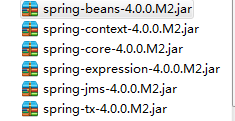Java中间件JMS(二)之ActiveMQ整合spring(一)
在上一章( Java中间件JMS之ActiveMQ入门http://blog.csdn.net/dengwanchuan/article/details/10241345)说到ActiveMQ能与spring进行整合,ActiveMQ与Spring进行整合有一定的好处,首先是可配置化,然后是能使用Spring的aop,tx等特性进行项目开发.
一.准备工作
我使用的是spring版本是4.0.0.M2,其他版本的也可以,只是配置不同,去Spring官网下载zip包,解开后将dist目录下的所有jar包(根据自己选择)拷贝到项目lib目录下并加入项目项目中的lib中,一般jms所需要的Spring的jar有:
二.代码开发
1.在src目录下新建applicationContext.xml文件并输入一下内容:
<?xml version="1.0" encoding="GBK"?>
<beans xmlns="http://www.springframework.org/schema/beans"
xmlns:xsi="http://www.w3.org/2001/XMLSchema-instance"
xsi:schemaLocation="http://www.springframework.org/schema/beans
http://www.springframework.org/schema/beans/spring-beans.xsd">
</beans>
2.引入spring,打开web.xml并将其内容修改为以下内容:
<?xml version="1.0" encoding="GBK"?> <web-app version="2.5" xmlns="http://java.sun.com/xml/ns/javaee" xmlns:xsi="http://www.w3.org/2001/XMLSchema-instance" xsi:schemaLocation="http://java.sun.com/xml/ns/javaee http://java.sun.com/xml/ns/javaee/web-app_2_5.xsd"> <context-param> <param-name>contextConfigLocation</param-name> <param-value>classpath*:applicationContext*.xml</param-value> </context-param> <servlet> <servlet-name>spring</servlet-name> <servlet-class> org.springframework.web.servlet.DispatcherServlet </servlet-class> <load-on-startup>1</load-on-startup> </servlet> <servlet-mapping> <servlet-name>spring</servlet-name> <url-pattern>/</url-pattern> </servlet-mapping> <welcome-file-list> <welcome-file>index.jsp</welcome-file> </welcome-file-list> </web-app>3.配置JMSTemplate模板
类似于jdbcTemplate,首先要配置一个ConnectionFactory,之后要开始配置JmsTemplate模板了。最后是配置消息目标了。消息分为队列(Queue)和主题(Topic)两大类。在applicationContext.xml中加入如下内容:
<!-- 配置JMS连接工厂 --> <bean id="connectionFactory" class="org.apache.activemq.ActiveMQConnectionFactory"> <property name="brokerURL" value="tcp://localhost:61616" /> </bean> <!-- 发送消息的目的地(队列) --> <bean id="queueDest" class="org.apache.activemq.command.ActiveMQQueue"> <!-- 设置消息队列的名字 --> <constructor-arg index="0" value="myQueue" /> </bean> <!-- 配置Jms模板 --> <bean id="jmsQueueTemplate" class="org.springframework.jms.core.JmsTemplate"> <property name="connectionFactory" ref="connectionFactory" /> <property name="defaultDestination" ref="queueDest" /> <!--<property name="receiveTimeout" value="10000" /> --> </bean> <!-- 发送消息的目的地(主题) --> <bean id="topicDest" class="org.apache.activemq.command.ActiveMQTopic"> <!-- 设置消息队列的名字 --> <constructor-arg index="0" value="myTopic" /> </bean> <!-- 配置TopicJms模板 --> <bean id="jmsTopicTemplate" class="org.springframework.jms.core.JmsTemplate"> <property name="connectionFactory" ref="connectionFactory" /> <property name="defaultDestination" ref="topicDest" /> <!-- 配置是否为发布订阅者模式,默认为false --> <property name="pubSubDomain" value="true"/> <!--<property name="receiveTimeout" value="10000" /> --> </bean>
receiveTimeout表示接收消息时的超时时间,设置的为10秒,因为如果不设置的话,加入接收消息时是阻塞着的,那么将一直阻塞下去。配置完成了。但是我不建议设置这个时间,如果到达设置时间之后,生产者没有运行,消费者接受到Message对象为null,测试可能会出现异常,而且消费者将停止接受消息.那么如何使用JmsTemplate发送消息呢?
spring的beanfactory得到一个jmsTemplate的实例和消息目标的实例,发送消息,够简单的吧。首先我们还从queue方式开始。下面我们就来编写具体代码。
4、编写Point-to-Point (点对点)代码
新建生产者类QueueProducerService.java,代码如下:
package jms.mq.spring;
import java.util.Date;
import javax.jms.Destination;
import javax.jms.JMSException;
import javax.jms.Message;
import javax.jms.Session;
import javax.jms.TextMessage;
import org.springframework.jms.core.JmsTemplate;
import org.springframework.jms.core.MessageCreator;
public class QueueProducerService{
JmsTemplate jmsTemplate;
Destination destination;
public void send() {
MessageCreator messageCreator = new MessageCreator() {
public Message createMessage(Session session) throws JMSException {
TextMessage message = session.createTextMessage();
message.setText("QueueProducerService发送消息"+new Date());
return message;
}
};
jmsTemplate.send(this.destination,messageCreator);
}
public void setJmsTemplate(JmsTemplate jmsTemplate) {
this.jmsTemplate = jmsTemplate;
}
public void setDestination(Destination destination) {
this.destination = destination;
}
}
生产者编写完了,下面我们来编写消费者,上面说了,发送消息的时候,spring的beanfactory得到一个jmsTemplate的实例和消息目标的实例,然后发送,那么接受的时候肯定也是得到一个jmsTemplate的实例和消息目标的实例,然后接受,下面我们来看具体代码。
新建一个消费者类QueueConsumerService.java,具体代码如下:
package jms.mq.spring;
import javax.jms.Destination;
import javax.jms.JMSException;
import javax.jms.TextMessage;
import org.springframework.jms.core.JmsTemplate;
public class QueueConsumerService{
JmsTemplate jmsTemplate;
Destination destination;
public void receive() {
TextMessage message = (TextMessage) jmsTemplate.receive();
try {
System.out.println("QueueConsumerService收到消息:"+message.getText());
} catch (JMSException e) {
e.printStackTrace();
}
}
public void setJmsTemplate(JmsTemplate jmsTemplate) {
this.jmsTemplate = jmsTemplate;
}
public void setDestination(Destination destination) {
this.destination = destination;
}
}
代码编写完毕,下面要进行bean的配置,在applicationContext.xml中加入如下代码实例化对象和依赖注入:
<bean id="queueProducerService" class="jms.mq.spring.QueueProducerService"> <property name="jmsTemplate" ref="jmsQueueTemplate" /> <property name="destination" ref="queueDest" /> </bean> <bean id="queueConsumerService" class="jms.mq.spring.QueueConsumerService"> <property name="jmsTemplate" ref="jmsQueueTemplate" /> <property name="destination" ref="queueDest" /> </bean>
需要的业务代码都已编写完毕,下面编写测试代码。新建一个生产者的测试类QueueProducerTest.java。具体代码如下:
package jms.mq.spring;
import org.springframework.context.ApplicationContext;
import org.springframework.context.support.ClassPathXmlApplicationContext;
public class QueueProducerTest {
private static ApplicationContext appContext = new ClassPathXmlApplicationContext( "applicationContext.xml");
private static void send() {
QueueProducerService producerService = (QueueProducerService) appContext.getBean("queueProducerService");
producerService.send();
}
/**
* @param args
*/
public static void main(String[] args) {
send();
}
}
再建一个消费者的测试类,QueueConsumerTest.java,具体代码如下:
package jms.mq.spring;
import org.springframework.context.ApplicationContext;
import org.springframework.context.support.ClassPathXmlApplicationContext;
public class QueueConsumerTest {
private static ApplicationContext appContext = new ClassPathXmlApplicationContext( "applicationContext.xml");
private static void receive() {
QueueConsumerService consumerService = (QueueConsumerService) appContext.getBean("queueConsumerService");
consumerService.receive();
}
public static void main(String[] args) {
receive();
}
}
5、运行point-point(点对点)程序
所有代码都编写完了,我们来看一下我们的劳动成果。运行生产者测试类。控制台打印出如下内容,画线标注的就是我们发送的内容:
6、编写Publisher/Subscriber(发布/订阅者)代码
新建发布者TopicPublisherService.java,内容如下:
package jms.mq.spring;
import java.util.Date;
import javax.jms.Destination;
import javax.jms.JMSException;
import javax.jms.MapMessage;
import javax.jms.Message;
import javax.jms.Session;
import javax.jms.TextMessage;
import org.springframework.jms.core.JmsTemplate;
import org.springframework.jms.core.MessageCreator;
import jms.spring.QueueProducerService;
public class TopicPublisherService{
JmsTemplate jmsTemplate;
Destination destination;
public void send() {
MessageCreator messageCreator = new MessageCreator() {
public Message createMessage(Session session) throws JMSException {
TextMessage message = session.createTextMessage();
message.setText("QueueProducerService发送消息"+new Date());
return message;
}
};
jmsTemplate.send(this.destination,messageCreator);
}
public void setJmsTemplate(JmsTemplate jmsTemplate) {
this.jmsTemplate = jmsTemplate;
}
public void setDestination(Destination destination) {
this.destination = destination;
}
}
再新建一个订阅者TopicSubscriberService.java,代码如下。
package jms.mq.spring;
import javax.jms.Destination;
import javax.jms.JMSException;
import javax.jms.TextMessage;
import org.springframework.jms.core.JmsTemplate;
import jms.spring.QueueConsumerService;
public class TopicSubscriberService{
JmsTemplate jmsTemplate;
Destination destination;
public void receive() {
TextMessage message = (TextMessage) jmsTemplate.receive();
try {
System.out.println("QueueConsumerService收到消息:"+message.getText());
} catch (JMSException e) {
e.printStackTrace();
}
}
public void setJmsTemplate(JmsTemplate jmsTemplate) {
this.jmsTemplate = jmsTemplate;
}
public void setDestination(Destination destination) {
this.destination = destination;
}
}
在配置文件中applicationContext.xml增加如下配置:
<bean id="topicPublisherService" class="jms.mq.spring.TopicPublisherService">
<property name="jmsTemplate" ref="jmsTopicTemplate"/>
<property name="destination" ref="topicDest"/>
</bean>
<bean id="topicSubscriberService" class="jms.mq.spring.TopicSubscriberService">
<property name="jmsTemplate" ref="jmsTopicTemplate"/>
<property name="destination" ref="topicDest"/>
</bean>
编写测试程序发布者测试类,TopicPublisherTest.java
package jms.mq.spring;
import org.springframework.context.ApplicationContext;
import org.springframework.context.support.ClassPathXmlApplicationContext;
public class TopicPublisherTest {
private static ApplicationContext appContext = new ClassPathXmlApplicationContext( "applicationContext.xml");
private static void send() {
TopicPublisherService topicPublisherService = (TopicPublisherService) appContext.getBean("topicPublisherService");
topicPublisherService.send();
}
public static void main(String[] args) {
send();
}
}
编写测试程序订阅者测试类,TopicSubscriberTest.java
package jms.mq.spring;
import org.springframework.context.ApplicationContext;
import org.springframework.context.support.ClassPathXmlApplicationContext;
public class TopicSubscriberTest {
private static ApplicationContext appContext = new ClassPathXmlApplicationContext( "applicationContext.xml");
private static void receive() {
TopicSubscriberService topicSubscriberService = (TopicSubscriberService) appContext.getBean("topicSubscriberService");
topicSubscriberService.receive();
}
public static void main(String[] args) {
receive();
}
}
7.Publisher/Subscriber(发布/订阅者)程序
先运行订阅者,再运行发布者,可以看到订阅者能打印信息;但是反之就不行,这就是Publisher/Subscriber(发布/订阅者)的特性;
跟Point-Point(点对点)对比的话,不管运行生存者还是消费者,都会打印信息,可以阅读前一章http://blog.csdn.net/dengwanchuan/article/details/10241345了解这两种模式的区别和联系。
附加完整的applicationContext.xml配置文件
<?xml version="1.0" encoding="GBK"?>
<beans xmlns="http://www.springframework.org/schema/beans"
xmlns:xsi="http://www.w3.org/2001/XMLSchema-instance"
xsi:schemaLocation="http://www.springframework.org/schema/beans
http://www.springframework.org/schema/beans/spring-beans.xsd">
<!-- 配置JMS连接工厂 -->
<bean id="connectionFactory"
class="org.apache.activemq.ActiveMQConnectionFactory">
<property name="brokerURL" value="tcp://localhost:61616" />
</bean>
<!-- 发送消息的目的地(队列) -->
<bean id="queueDest"
class="org.apache.activemq.command.ActiveMQQueue">
<!-- 设置消息队列的名字 -->
<constructor-arg index="0" value="myQueue" />
</bean>
<!-- 配置Jms模板 -->
<bean id="jmsQueueTemplate"
class="org.springframework.jms.core.JmsTemplate">
<property name="connectionFactory" ref="connectionFactory" />
<property name="defaultDestination" ref="queueDest" />
<!--<property name="receiveTimeout" value="10000" /> -->
</bean>
<!-- 发送消息的目的地(主题) -->
<bean id="topicDest"
class="org.apache.activemq.command.ActiveMQTopic">
<!-- 设置消息队列的名字 -->
<constructor-arg index="0" value="myTopic" />
</bean>
<!-- 配置TopicJms模板 -->
<bean id="jmsTopicTemplate"
class="org.springframework.jms.core.JmsTemplate">
<property name="connectionFactory" ref="connectionFactory" />
<property name="defaultDestination" ref="topicDest" />
<!-- 配置是否为发布订阅者模式,默认为false -->
<property name="pubSubDomain" value="true"/>
<!--<property name="receiveTimeout" value="10000" /> -->
</bean>
<bean id="queueProducerService" class="jms.mq.spring.QueueProducerService">
<property name="jmsTemplate" ref="jmsQueueTemplate" />
<property name="destination" ref="queueDest" />
</bean>
<bean id="queueConsumerService" class="jms.mq.spring.QueueConsumerService">
<property name="jmsTemplate" ref="jmsQueueTemplate" />
<property name="destination" ref="queueDest" />
</bean>
<bean id="topicPublisherService" class="jms.mq.spring.TopicPublisherService">
<property name="jmsTemplate" ref="jmsTopicTemplate"/>
<property name="destination" ref="topicDest"/>
</bean>
<bean id="topicSubscriberService" class="jms.mq.spring.TopicSubscriberService">
<property name="jmsTemplate" ref="jmsTopicTemplate"/>
<property name="destination" ref="topicDest"/>
</bean>
</beans>

